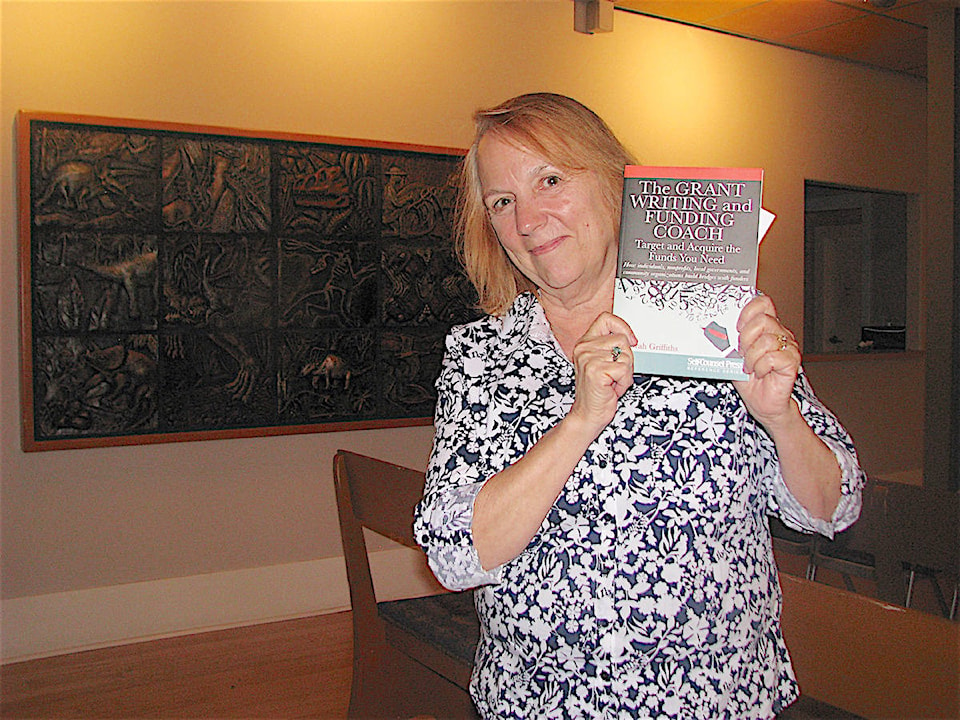Asking a group or government for money for your group’s important project is a frightening process.
Where to begin?
The good news is that most funding groups really want to help you.
Even better news, is that a Comox Valley woman who’s been there and done that in the world of grant-seeking for 25 years has written an entertaining handbook to help you write a good grant application.
Deborah Griffiths, the director of the Courtenay Museum and Archives, works on the side as a professional grant writer.
She’s operated her own business for the past 16 years, helping groups apply for grants, and reviewing applications for funders.
(Cont. on page 18)
Griffiths works on a contract basis for the Museum which gives her the flexibility to run her grant-writing business on the side.
She had originally printed up a “little book” for some of her clients so that they could get some tips on making grant proposals.
Self-Counsel Press saw that booklet and asked Griffiths if she would expand on it for a book in their popular self-help series.
“The Grant Writing and Funding Coach – Target and Acquire the Funds You Need” is the result.
The book sets out to explain how individuals, non-profits, local government and community organizations can “build bridges with funders.”
Griffiths, who took degrees in anthropology and English before adding a Masters in Learning and Training, loves the ‘writing’ part of grant applications.
Her approach is first using the “five W’s and an H” approach from journalism, a field she studied in high school and was inspired there by the teacher.
The “five W’s”, of course, are Who, What, When, Where and Why, with the “H” of How thrown in for good measure.
Griffiths has tried to demystify and de-jargonize the grant writing process.
“I’ve … learned that the business of writing grants and applying for funds is sometimes presented as being more complicated than it actually is, even though there is great need for it in some communities,” Griffiths writes.
“If you are seeking a highly technical, academic-speak book about grants and funding, this isn’t it This is, pure, business-like, pleasure-reading about idea advancement backed with solid experience and information from people in the business of applying for and giving funds in the form of grants.”
And Griffiths puts a lot of the “F-word” in the book - “Fun”.
She writes about philanthropy and saying ‘thank you’; being honest and straightforward; making sure you follow funders’ criteria so you’re not wasting their time and yours; telling a full, honest story; focusing on the benefits of your project; showing how you can financially sustain the project; even on using professionally-done graphics, and good quality paper, for your written presentation.
“You’re providing an opportunity to funders. They want projects that fit with what they’re trying to do in the community,” she said. “The word count doesn’t matter … It’s how you can get to the point with what you need.”
Griffiths said she’s worked on many grant applications for really interesting projects, everything from recycling to forest preservation.
“I’ve had turn-downs … but I notice there’s a pretty good success rate with certain approaches,” she said.
Those approaches are clearly outlined in the new book, focusing on a sample project throughout. This project includes narrative and budget summaries, checklists for staying organized and a general view of matching fund possibilities such as crowdfunding.
Above all, the book “encourages you to tell your story.”
“A true and compelling story is at the heart of all successful grants, whether you are requesting hundreds, thousands, or more. When you inspire your funders with a true story, you’ll see results.”
And yes, “keep it simple”. In grant writing, less is more, advises Griffiths.
Her approach works. She has obtained $2.5 million in grants for the Courtenay Museum over the years.
For more information and more tips about grant writing go to www.griffithscommunications.com
